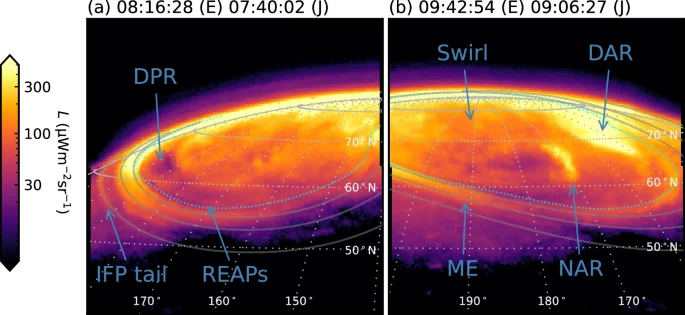
James Webb Telescope Uncovers Jupiter’s Dazzling Auroras: A Celestial Light Show
The James Webb Space Telescope (JWST) has once again delivered breathtaking images, this time capturing the dynamic and intense auroras of Jupiter in never-before-seen detail. These observations, taken on Dec. 25, 2023, are reshaping our understanding of the gas giant's magnetosphere and the processes that drive its brilliant polar lights. Why does this matter? Because these insights not only illuminate the complexities of Jupiter but also offer clues about the atmospheres and magnetic fields of exoplanets beyond our solar system.
Stunning Auroras: Brighter and Faster Than Expected
Scientists were astounded by the dynamism and brightness of Jupiter's auroras, far exceeding those on Earth. "What a Christmas present it was — it just blew me away!" exclaimed Jonathan Nichols from the University of Leicester, lead author of a new study published in Nature Communications. Nichols and his team used the JWST's NIRCam (Near-Infrared Camera) alongside ultraviolet sensors on the Hubble Space Telescope, to capture unprecedented details.

One surprising discovery was that the brightest light observed by Webb had no counterpart in Hubble's pictures. "In order to cause the combination of brightness seen by both Webb and Hubble, we need to have a combination of high quantities of very low-energy particles hitting the atmosphere, which was previously thought to be impossible. We still don't understand how this happens," Nichols explained.
The Role of Volcanic Moons and Solar Wind
Like Earth, Jupiter's auroras are formed when high-energy particles from the sun's solar wind interact with the planet's magnetic field. However, Jupiter has an additional source: particles ejected from volcanoes on its moon Io. These particles also contribute to the auroral display, making Jupiter's auroras hundreds of times brighter than Earth's.
Another study published in Nature Communications, titled "Dynamic infrared aurora on Jupiter”, dives into the detailed analysis of the composition of the emission captured. Showing that Jupiter's H3+ morphology is more variable than inferred from previous observations and that is more variable than inferred from previous observations.
Key Findings and Unanswered Questions
- Variable Auroral Morphology: JWST's high-sensitivity observations revealed variability in the auroral morphology with timescales down to seconds, exhibiting phenomena like rapidly-propagating pulsations.
- H3+ Emission: Data showed that emission from the trihydrogen cation (H3+) in the auroras is far more variable than previously believed.
- Rapid Extinctions Highlight rapid reduction events of light, as described in the study led by Nichols in Nature Communications
- Unexplained Brightness: The discrepancy between Webb and Hubble's observations raises questions about the particles and processes involved.
Implications for Jupiter's Magnetosphere
Researchers plan to continue studying these phenomena using both Hubble and the JWST to better understand how the suspected combination of particles might be reaching Jupiter's atmosphere. The insights gained could reveal new details about Jupiter's magnetosphere, the region of space around the planet affected by its magnetic field.

What does this mean for the bigger picture? Understanding Jupiter's auroras and magnetosphere can provide insights into similar phenomena on other planets, including exoplanets. As we continue to explore the cosmos, these observations serve as a reminder of the dynamic processes at play in our universe.
What are your thoughts on these new findings? Let us know in the comments below!